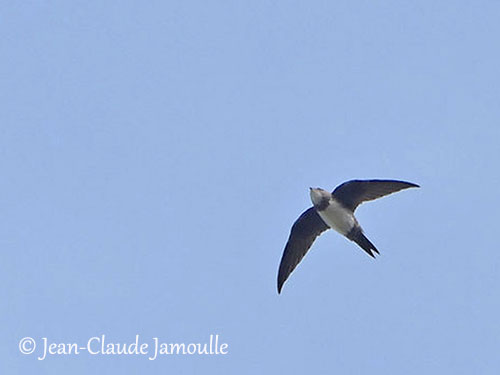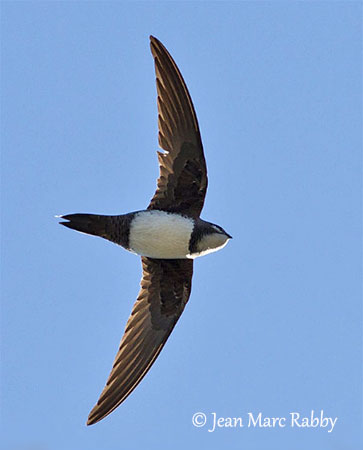
Fr: Martinet à ventre blanc
Ang: Alpine Swift
All: Alpensegler
Esp: Vencejo Real
Ita: Rondone maggiore
Nd: Alpengierzwaluw
Sd: alpseglare
Photographers:
John Anderson
John Anderson Photo Galleries
Jean-Claude Jamoulle
A la rencontre des Oiseaux
William Price
PBase-tereksandpiper & Flickr William Price
Jean Marc Rabby
Des Ailes et des Plumes
Text by Nicole Bouglouan
Sources:
HANDBOOK OF THE BIRDS OF THE WORLD Vol 5 by Josep del Hoyo-Andrew Elliott-Jordi Sargatal - Lynx Edicions - ISBN: 8487334253
BIRDS OF AFRICA SOUTH OF THE SAHARA by Ian Sinclair and Peter Ryan - Princeton University Press Princeton and Oxford - ISBN: 0691118159
BIRDS OF THE MIDDLE EAST by R.F. Porter, S. Christensen, P Schiermacker-Ansen C.Helm - ISBN: 0713670169
ENCYCLOPEDIE DES OISEAUX DE FRANCE ET D’EUROPE – de Peter Hayman et Rob Hume - Flammarion – ISBN : 2082009920
L’ENCYCLOPEDIE MONDIALE DES OISEAUX - Dr Christopher M. Perrins - BORDAS - ISBN: 2040185607
THE HANDBOOK OF BIRD IDENTIFICATION FOR EUROPE AND THE WESTERN PALEARCTIC by Mark Beaman, Steve Madge - C. Helm - ISBN: 0713639601
Animal Diversity Web (University of Michigan Museum of Zoology)
Biodiversity Explorer – The Web of Life in Southern Africa
Pájaros de España (JL Beamonte)
Study shows alpine swift can stay aloft for 200 days
Alpine Swift
Tachymarptis melba
Apodiformes Order – Apodidae Family
INTRODUCTION:
The Alpine Swift is almost twice as large as other swifts. In flight, it is often similar to a small falcon.
Ten subspecies share the wide range in southern Europe from Portugal to Bulgaria, to sub-Saharan Africa, Madagascar and India.
The Alpine Swift spends most of its life flying in the air. It feeds, drinks, sleeps and mates while in the air. It nests on rocky cliffs and mountains, but also on tall buildings. It usually returns to the same nesting site every year.
This species is not globally threatened, but the nesting birds are vulnerable to severe weather.

DESCRIPTION OF THE BIRD:
Biometrics:
Length: 20-22 cm
Wingspan: 53 cm
Weight: (nominate race) 76-120 g
The Alpine Swift of nominate race has olive-brown head and upperparts, breast band, underwing, flanks and undertail-coverts.
Chin, throat and belly are white, the latter forming a large oval white patch conspicuous in flight.
The long, scythe-like wings favour gliding action and is advantageous during flapping flight. The tail is slightly forked and used as support when the bird clings to a steep, vertical rock face.
The short, tiny bill is black, with very large gape allowing easier aerial capture of insects. The eyes are dark brown, protected by coarse, bristle-like feathers located in front of the eye. The short legs and the tiny feet are black. The feet have sharp, curved claws, very useful to help the bird to perch on vertical surfaces.
Both adults are similar.
The juvenile resembles adult but it has pale-edged feathers.
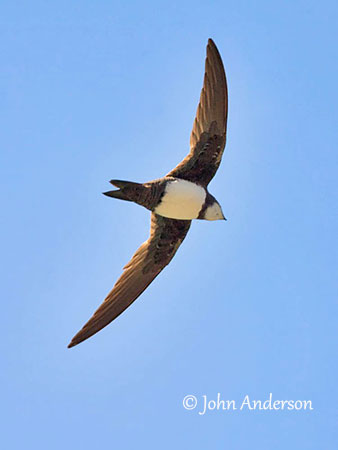
SUBSPECIES AND RANGE:
The Alpine Swift has ten subspecies.
T.m. bakeri is found in Sri Lanka.
T.m. nubifugus is in the Himalayas.
T.m. willsi is on Madagascar.
T.m. marjoriae occurs in NC Namibia and NW South Africa.
T.m. africanus is found in Ethiopia to South Africa and SW Angola.
T.m. maximus occurs in Rwenzori Mts (DR Congo and Uganda)
T.m. archeri is found in N Somalia and SW Arabia to Jordan and Israel.
T.m. tuneti is in Morocco, Middle East and E to W Pakistan.
T.m. melba is found in Southern Europe, Turkey to NW Iran.
T.m. dorabtatai occurs in W India.
These races differ by paler or darker plumages, body and wing size, and of white patches and dark breast band. The race “maximus” is the largest with a weight of 128 grams and very dark, blackish plumage.
HABITAT:
For most of swifts, the habitat is a site where prey are taken. The Alpine Swift avoids areas with numerous obstructions such as trees and buildings (except for nesting).
It breeds on cliffs in hills and mountains, gorges, coastal cliffs, occasionally in tree holes. It nests in caves and rock crevices in cliffs. It is also found in tall buildings in towns and cities. It usually breeds below 1500 metres, occasionally to 2300 metres or higher according to the range. In Himalayas, it forages up to 3700 metres of elevation.
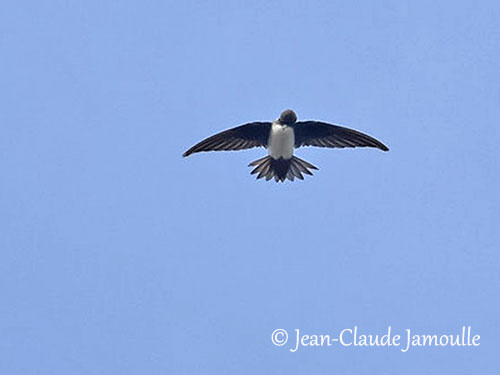
CALLS AND SONGS: SOUNDS BY XENO-CANTO
The Alpine Swift’s typical call is a loud, metallic trill rising and falling in pitch, and accelerating, then slowing down “trihihihihihihihihi…” or “trrr-titititititi…”
Other loud calls “kee-kee-kee-kee” and “peee-hu” can sound like small falcon’s calls.
BEHAVIOUR IN THE WILD:
The Alpine Swift feeds exclusively on insects and spiders. The diet includes various species such as Hemiptera, Hymenoptera, Coleoptera, Diptera and spiders.
It forages in flight, between 30 and 40 metres above the ground. The bird catches insects while flying by opening the bill widely to snap up prey.
The Alpine Swift is sometimes taken by the Sooty Falcon while foraging. It may feed at lower level during bad weather conditions, and at night around the lights that attract numerous insects, and sometimes in total darkness.
During the breeding season, it performs aerial displays. The pairs often break from the groups and fly together. Another sequence involves two males chasing a female between some physical obstructions, while constantly calling loudly. These flights may last more than five minutes, and the birds may reach up to 150 metres above the ground at flight peak. The males rarely fight during these displays.
The Alpine Swift is monogamous with long-term pair bonds of more than 10 years. The copulation occurs at nest or in the air, after the aerial displays.
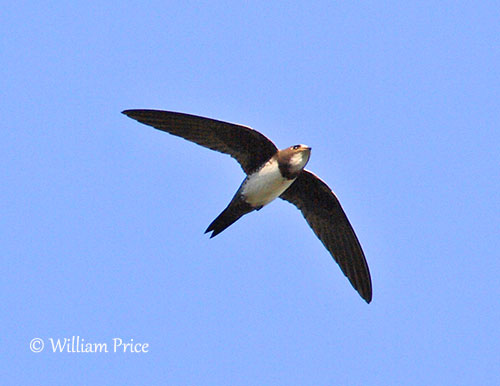
The Alpine Swift is migratory and usually flies at high altitude, but these movements can be observed only when wet or windy weather force the birds down. They cover long distances of about 1000km/day.
The Palearctic breeding birds leave the breeding grounds in September/mid-October, and return from mid-February. They migrate in single-species groups and in smaller flocks than the Common Swift. Some races of Africa and India do not disperse after breeding.
Some vagrants are recorded in British Islands, C and N Europe, Barbados (Caribbean) and there is a single record in French Guiana.
The Alpine Swift is less agile and performs slower wingbeats than the Common Swift. However, it looks more powerful and performs prolonged glides on slightly drooped wings, recalling sometimes the Eurasian Hobby. The flight is powerful and elegant, reaching speeds of up to 110km/hour.
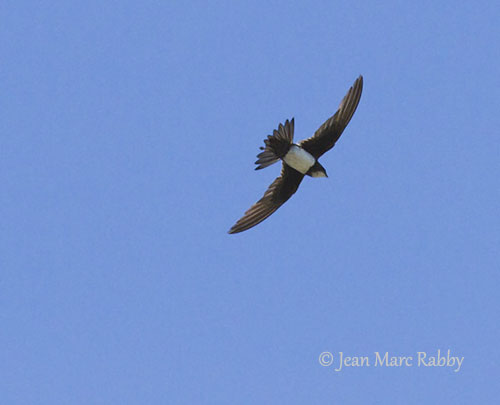
REPRODUCTION OF THIS SPECIES:
The breeding season is closely related to prey abundance. It takes place in spring, from March to August in northern hemisphere, and from September to January in South Africa.
The Alpine Swift breeds in colonies established on cliff ledges and in crevices, and also on tall buildings. The same nesting site is reused in several following years by the same pair. A colony may contain up to 170 pairs.
The nest is a cup-shaped structure made with feathers, sticks, plant fibers and down, and moss. All these materials are held together with saliva. In the same way, the nest is glued to the vertical surface, once again with saliva.
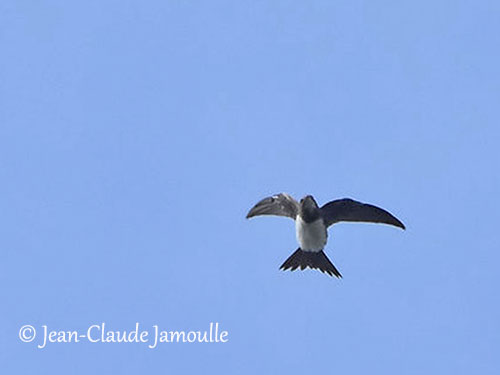
The female lays 1-4, usually 3 eggs, and both adults share the incubation during 17-23 days. The chicks hatch within 24 hours. They are naked, and brooded continuously until the down appears. They are fed by both parents on a rich diet of insects, brought back by an adult in the form of a bolus which is regurgitated directly in the throat of the chick. The young fledge between 53 and 66 days after hatching. They can breed at 2-3 years, rarely at one year.
The nest site is defended by the adults, and threat displays are performed with raised wings to expose the strong feet and claws. Fighting occurs only after the threat displays. Aggression is often the result of competition for nest sites, and conflicts occur between the Alpine Swift and feral pigeons.
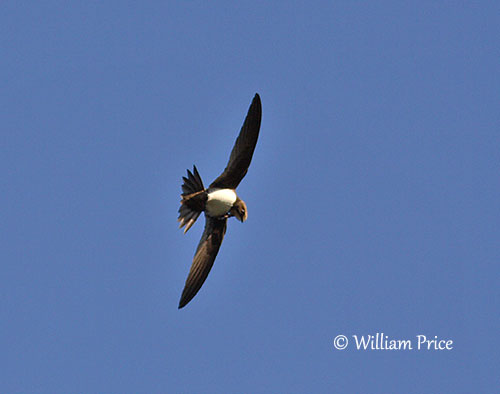
PROTECTION / THREATS / STATUS:
The Alpine Swift is locally fairly common to common throughout the range and even locally abundant in some regions.
Some colonies can be lost due to severe weather or strong winds, but the nests are usually located in inaccessible sites.
A very preliminary estimate of the global population size is 1,000,000/4,000,000 individuals. This population is stable and currently, the Alpine Swift is evaluated as Least Concern.
